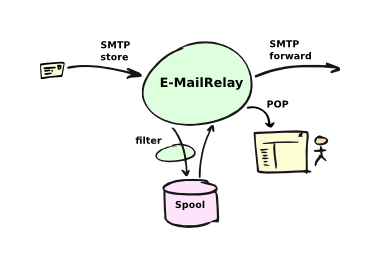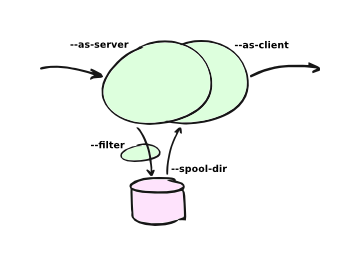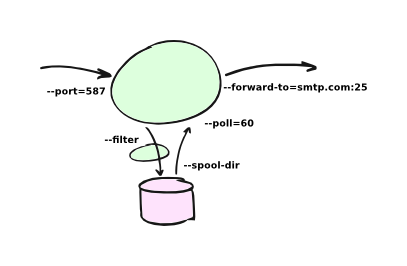E-MailRelay Readme
Abstract
E-MailRelay is an e-mail store-and-forward message transfer agent and proxy server. It runs on Unix-like operating systems (including Linux and Mac OS X), and on Windows.
E-MailRelay does three things: it stores any incoming e-mail messages that it receives, it forwards e-mail messages on to another remote e-mail server, and it serves up stored e-mail messages to local e-mail reader programs. More technically, it acts as a SMTP storage daemon, a SMTP forwarding agent, and a POP3 server.
Whenever an e-mail message is received it can be passed through a user-defined program, such as a spam filter, which can drop, re-address or edit messages as they pass through.

E-MailRelay uses the same non-blocking i/o model as Squid and nginx giving excellent scalability and resource usage.
C++ source code is available and distribution is permitted under the GNU General Public License V3.
Quick start
To use E-MailRelay in store-and-forward mode use the --as-server option to start the storage daemon in the background, and then do delivery of spooled messages by running with the --as-client option.

For example, to start a storage daemon listening on port 587 use a command like this:
emailrelay --as-server --port 587 --spool-dir /tmp
And then to forward the spooled mail to smtp.example.com run something like this:
emailrelay --as-client smtp.example.com:25 --spool-dir /tmp
To get behaviour more like a proxy you can add the --poll and --forward-to options so that messages are forwarded continuously rather than on-demand.

This example starts a store-and-forward server that forwards spooled-up e-mail every minute:
emailrelay --as-server --poll 60 --forward-to smtp.example.com:25
Or for a proxy server that forwards each message soon after it has been received, you can use --as-proxy or add --forward-on-disconnect:
emailrelay --as-server --forward-on-disconnect --forward-to smtp.example.com:25
To edit or filter e-mail as it passes through the proxy specify your filter program with the --filter option, something like this:
emailrelay --as-proxy smtp.example.com:25 --filter addsig.js
To run E-MailRelay as a POP server without SMTP use --pop and --no-smtp:
emailrelay --pop --no-smtp --log --close-stderr
The emailrelay-submit utility can be used to put messages straight into the spool directory so that the POP clients can fetch them.
By default E-MailRelay will always reject connections from remote networks. To allow connections from anywhere use the --remote-clients option, but please check your firewall settings to make sure this cannot be exploited by spammers.
For more information on the command-line options refer to the reference guide or run:
emailrelay --help --verbose
Packages
To install on Linux from a RPM or DEB package:
sudo $SHELL # or 'su' rpm -i emailrelay*.rpm # if RPM dpkg -i emailrelay*.deb # if DEB
If your Linux system uses systemd then you should check the E-MailRelay configuration file /etc/emailrelay.conf is as you want it and then run:
systemctl enable emailrelay systemctl start emailrelay systemctl status emailrelay
On other systems try these commands:
cp /usr/lib/emailrelay/init/emailrelay /etc/init.d/ update-rc.d emailrelay enable || rc-update add emailrelay invoke-rc.d emailrelay start || service emailrelay start tail /var/log/messages /var/log/syslog 2>/dev/null
On Windows run the setup program.
Documentation
The following documentation is provided:
- README -- this document
- COPYING -- the GNU General Public License
- INSTALL -- generic build & install instructions
- AUTHORS -- authors, credits and additional copyrights
- userguide.txt -- user guide
- reference.txt -- reference document
- ChangeLog -- change log for releases
Source code documentation will be generated when building from source if doxygen is available.